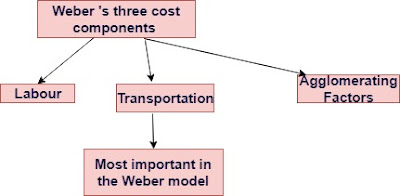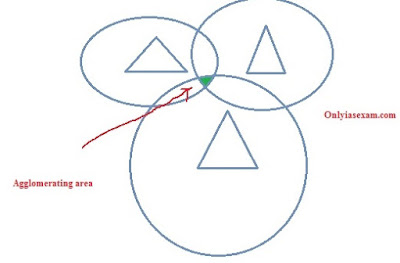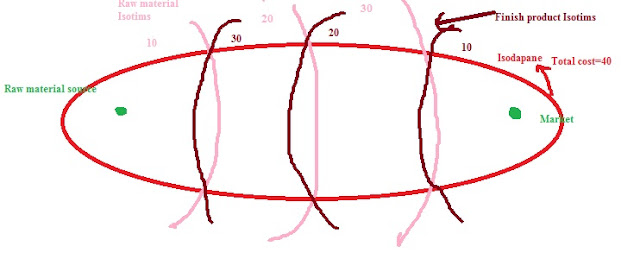For maximizing the profits of industries, there are two ways:
- The first approach is to increase the profits of the industry by reducing the total manufacturing cost by reducing the transportation cost of raw materials and finished goods and other manufacturing expenses.
- Another way is to maximize profits by maximizing the revenue of the industries.
The Losch model of industrial location is based on locating the optimum location of industries where the demand and price of finished goods are maximum. Due to maximum demand and price, the revenue of the industry is high.
Weber's model of industrial location is based on finding the optimum location of industries where manufacturing costs can be minimized. The focus is on increasing the profitability of the industry by reducing the manufacturing cost.
We will study here Weber's model of industrial location.
Brief about Weber's model of industrial location:
- Alfred Weber[ younger brother of well-known sociologist Max Weber], a German economist, gave the theory of industrial location in 1909. The industrial location theory of Alfred Wever is considered the modern location theory of Industries.
- His theory emphasized the "pull factors" of geographic location that attract particular industries.
- According to Weber, industries will be located where there is a reduction in the cost of production due to the transportation cost, labor cost, and agglomeration economies.
- He explained the concept with the help of Location Triangle, Isotimes, and Isodapane. We will discuss all his concepts in detail in this article.
What is the Industrial Location theory?
Industrial location theory helps in finding out the best location suitable for particular industries or it also locates industries suitable for a particular location. Therefore, industrial location theory answers two main questions:
- The first is why are certain industries attracted to certain places?
- Second, why are certain industries attracted to a specific location?
Weber's model of industrial location answers the first question and it helps to find out the optimum location of the industry where "pull factors" are favorable to industries.
There are two types of pull factors:
Regional Factors:
It is also called the locational figures. The following are the regional factors:
- Regional Factors
- Agglomeration factors
Regional Factors:
It is also called the locational figures. The following are the regional factors:
- Cost of land
- Labor cost
- Raw material cost and availability
- Transportation cost
- Fuel, power, and machinery cost.
Agglomeration Factors:
- Aggregation factors like availability of technical expertise, the interconnectedness of production of different industries, availability of market, etc, lead to the same type of industries at a particular place.
What are the basic assumptions in the Weber model of industrial location?
- The geographic region consists of an isotropic surface.
- Transport cost is proportional to weight and distance
- Industrialists, buyers, and sellers make economic decisions.
- There is perfect competition in the market.
What are the three components of Weber's theory of industrial location?
Weber considered the following three components for considering the input cost of industries.
- Labour
- Transportation
- Agglomerating
 |
| Weber's model of industrial location |
Transportation Cost:
As per Weber, the transportation costs of industries are largely determined by the transportation cost of raw materials and finished goods. Raw materials are in two types:
- Localized
- Ubiquitous
Ubiquitous raw materials are found everywhere and that is air, water, etc.
The optimum location would be where the transportation cost is minimum. Transportation cost is calculated on the basis of the distance and weight of goods. Distances are:
- Distance from the source of raw materials to industry
- Distance from industry to market
- These are those raw materials that have the same weight as the finished goods made after industrial processing.
- Some raw materials lose weight during industrial processing. Finished goods made from such raw materials have a low weight
Types of industrial location in the Weber Model?
There are two types of industrial locations:
- Linear Location
- Non-Linear location
 |
| Weber Industrial location |
Linear Location
When the industry uses the same raw material, the location of the industry will be in the linear between the raw material source and the market.
The following are three cases to locate the industry:
Case-1:
Case-3:
- When raw material is ubiquitous in nature, it would be good to place the industry closer to the market to save the transportation cost.
Case-2:
- When the raw material is pure and localized in nature, the industry can be placed anywhere between the source of the raw material and the market, and the transportation cost will be the same.
- When the raw material is impure, the industry has to be located near the raw material to save the transportation cost
Non-Linear location:
When an industry needed two raw materials then the following case was found:Case 1:
- (both raw materials are ubiquitous ) OR ( one raw material is ubiquitous and the second raw material is pure) OR (both the raw materials are pure) then the industry location would be in-market to save transportation costs.
There are difficult to find out the location of the industry if both the raw materials are localized. The preferred location would be near those raw materials which are more impure.
Concept of Isotims :
Concept of Isodapane:
 |
| Case 1 nonlinear location |
 |
| Case 2 nonlinear location |
Concept of Isotims :
- Isotims are lines connecting equal transportation cost of raw material or equal transportation cost of the final product to market. Wherever on the isotim line, if we establish an industry, the transportation cost of raw material / final product is the same there.
- For example, if there is a line of isotims from a to b, then at any point from a to b, if we established industry, then the cost of transportation of goods which will come at point a will also come to b.
- Keep in mind that only one of the transportation costs either raw material or finished goods is considered here.
Concept of Isodapane:
- Isodapane is the line connecting with equal total transportation cost( raw materials and final product transportation).
- The circle in the following image is Isodapane.
- If the industry is installed in any place on Isodapane then the cost of the total transportation cost of raw materials and final goods will be the same.
Labor cost:
As per Weber, if saving in labor costs is greater than transportation costs, then the industry will be shifted to cheap labor cost areas. Weber gave two concepts for accounting for the labor cost:
- Critical Isodapane
- Agglomeration concept
What is the critical Isodapane?
- Critical Isodapane is lines or circles where there is a high transportation cost as compared to the Isodapane's transportation costs but labor cost is less as compared to Isodapane's location.
- Additional transportation cost of Isodapane is balanced by saving on labor costs on the critical Isodapane.
- We may install the industry on critical Isodapane because the overall cost[transportation cost and labor cost] is the same as in Isodapane.
What are Agglomeration concepts in the weber model?
- According to Weber, if the industry is established in the meeting area of three isodopane lines of the same type of industry, then the transportation or labor cost will be further reduced.
- The optimum location of the industries should be in the meeting areas of three isodopanes or significant isodopanes.
 |
Agglomeration concepts in the weber model |
Criticism of Weber's Model of Industrial Location:
- In the transportation cost, importance was given to only the distance and weight of materials, and importance to types of transport, quality of goods, and topography are ignored. Because of this, it seems unrealistic.
- An unlimited supply of labor is unrealistic.
- There is not a fixed point in the market, consumptions are scattered in many places. Due to the globalized world, market areas change very rapidly.
- Weber ignored the importance of demands, he focused on the supply side only.
- Weber ignored the role of high land costs in agglomeration areas.
- Social and political stability and influence is not considered in this model.
Try to solve the following questions.
- Discuss the theories of Industrial location propounded by any two of the following: Weber: Hoover and Smith. (UPSC 1992, 15 marks)
- Critically examine Alfred Weber’s Theory of the Location of Industries. (UPSC 1997, 12 marks)
- Explain the concept of Isodapne in the theory of Industrial Location. ( UPSC 2011, 12 marks)
- Explain the concept of ‘Isodapane’. (UPSC 2016, 10 marks)
- Explain the concept of Isotims.
- Present a critical account of Alfred Weber's Theory of Industrial location. (UPSC 2021, 15 Marks)
- Analyze the dynamics of Industrial location in the metropolitan cities of India. (UPSC 2020, 15 marks)
Answer the following multiple-choice question on Weber's model of industrial location:
1. For his model of Industrial location, Weber makes use of?
a) Isogons
b) Isophenes
c) Isodapanes
d) Isotachs
Answer. c) Isodapanes
2. The Location triangle concept for finding the optimum location of Industries was given by?
a) Max Weber
b) Alfred Weber
c) Karl Marx
d) August Losch
Answer. b) Alfred Weber
3. The line connecting to equal total transportation cost in the Alfred model is called?
a) Locational Triangle
b) Isotims
c) Isodapanes
d) Critical Isodapanes
Answer. c) Isodapanes
4. Alfred Weber was?
a) British
b) French
c) German
d) Russian
Answer. c) German
5. Alfred Weber Model is a?
a) Least cost theory
b) Profit maximizer model
c) Market capture model
d) Supply chain model
Answer. a) Least cost theory
6. Which of the following factor is not the three primary factors of the Alfred Wever Model?
a) Transport Cost
b) Advertisement Cost
c) Labor cost
d) Agglomeration economies
Answer. b) Advertisement Cost
7. Which of the following is not a basic assumption of Weber's model of industrial location?
a) Economic rationalities of Human beings
b) Isotropic plain
c)Industries operating in more than one country.
d) Only one finished product is considered at a time
Answer. c) Model is operative in more than one country
8. A line of equal transport cost for any raw material or finished product is called?
a) Locational Triangle
b) Isotims
c) Isodapanes
d) Critical Isodapanes
Answer. b) Isotims
9. Profit maximizer theory was given by?
a) Max Weber
b) Alfred Weber
c) Karl Marx
d) August Losch
Answer. d) August Losch
10. High cost of living, very high land cost, shortage of biosphere reserve, corruptions, and other is agglomerating areas is referred to?
a) Agglomeration economies
b) Agglomeration diseconomies
c) Fraud location
d) Corrupt location
Answer. b) Agglomeration diseconomies
You may like also:






2 Comments
Click here for CommentsWow
Replygood explanation ' ... thanks .........
ReplyConversionConversion EmoticonEmoticon